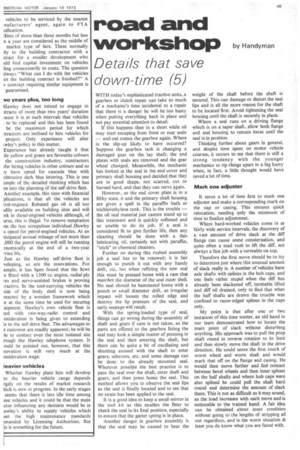road and
Page 51

If you've noticed an error in this article please click here to report it so we can fix it.
workshop by Handyman
Details that save down-time (5)
WITH today's sophisticated tractive units, a gearbox or clutch repair can take so much of a mechanic's time incidental to a repair that there is a danger he will be too hasty when putting everything back in place and not pay essential attention to detail.
If this happens then in a short while oil may start escaping from front or rear seals — and out comes the gearbox again. Where is the slip-up likely to have occurred? Suppose the gearbox task is changing a damaged gear on the lay shaft: the end plates with seals are removed and the gear wheel changed. Meanwhile, the mechanic has looked at the seal in the end cover and primary shaft housing and decided that they are in good shape, not scarred, cut or burned hard, and that they can serve again.
However, as the end cover plate is in a filthy state, it and the primary shaft housing are given a spell in the paraffin bath or trichlorethylene tank. This is the trouble — the oil seal material just cannot stand up to this treatment and is quickly softened and so unable to do its job. If a seal is considered fit to give further life, then any cleaning should be done with a thin lubricating oil, certainly not with paraffin, "trich" or chemical cleaners.
Further on during this rushed assembly job a seal has to be renewed; it is fair enough to punch it out with any handy drift, etc, but when refitting the new seal this must be pressed home with a ram that matches the diameter of the seal outer shell. No seal should be hammered home with a punch or small diameter drift, as irregular impact will loosen the rolled edge and destroy the lip pressure of the seal, and early seepage will result.
With the spring-loaded type of seal, things can go wrong during the assembly of shaft and gears if care is not taken, as the parts are offered to the gearbox fitting the seal may look a simple matter of pressing in the seal and then entering the shaft, but there can be quite a bit of oscillating and shunting around with the shaft to enter gears, selectors, etc, and some damage can be done to the already mounted seal. Wherever possible the best practice is to pass the seal over the shaft, enter shaft and gears, and then press home the seal. This method allows you to observe the seal lips as the seal is finally located and to see that no strain has been applied to the seal.
It is a good idea to keep a small mirror in the tool kit as this enables the fitter to check the seal in its final position, especially to ensure that the garter spring is in place.
Another danger in gearbox assembly is that the seal may be caused to bear the weight of the shaft before the shaft is secured. This can damage or distort the seal lips and is all the more reason for the shaft to be located first. Avoid tightening the seal housing until the shaft is securely in place.
Where a seal runs on a driving flange which is on a taper shaft, allow both flange and seal housing to remain loose until the seal is in position.
Thinking further about gears in general, and despite time spent on motor vehicle courses, it occurs to me that there is still a strong tendency with the younger mechanics to rip things apart in a big hurry when, in fact, a little thought would have saved a lot of time.
Mark one adjuster It saves a lot of time first to mark one adjuster and make a corresponding mark on the cap or casing. This ensures quick relocation, needing only the minimum of time to finalize adjustment.
Where hard-worked vehicles come in at fairly wide service intervals, the discovery of a vast amount of drive slack at the duff flange can cause some consternation, and quite often a mad rush to lift the dill, not always a fast job with a turntable on top.
Therefore the first move should be to try to determine just where this unusual amount of slack really is. A number of vehicles have axle shafts with splines in the hub caps, and one feels rather stupid when the diff has already been slackened off, turntable lifted and dill oil drained, only to find that when the half shafts are drawn the trouble was confined to razor-edged splines in the caps only.
My point is that after one or two instances of this time waster, an old hand in our team demonstrated how to locate the main point of slack without disturbing anything. His approach was to pull the prop shaft round in reverse rotation to its limit and then slowly move the shaft in the drive direction. He could sense the first touch of worm wheel and worm shaft and would mark that off on the flange and casing. He would then move farther and feel contact between bevel wheels and then inner splines on the half shafts and where hub caps were also splined he could pull the shaft hard round and determine the amount of slack there. This is not as difficult as it may sound, as the load increases with each move and is noticeable to the trained hand. A fair idea can be obtained about inner condition without going to the lengths of stripping all out regardless, and in the worst situation dt least you do know what you are faced with.




















































































































